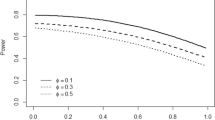Abstract
Motivated by the effect hierarchy principle, Zhang et al. (Stat Sinica 18:1689–1705, 2008) introduced an aliased effect number pattern (AENP) for regular fractional factorial designs and based on the new pattern proposed a general minimum lower-order confounding (GMC) criterion for choosing optimal \(2^{n-m}\) designs. Zhang et al. (Stat Sinica 18:1689–1705, 2008) proved that most existing criteria can be obtained by functions of the AENP. In this paper we propose a simple method for the calculation of AENP. The method is much easier than before since the calculation only makes use of the design matrix. All 128-run GMC designs with the number of factors ranging from 8 to 32 are provided for practical use.
Similar content being viewed by others
References
Bisgaard S (1994) A note on the definition for blocked \(2^{n-p}\) designs. Technometrics 36:308–311
Block RM (2003) Theory and construction methods for large regular resolution IV designs. Ph.D. dissertation, University of Tennessee, Knoxville. Available at http://etd.utk.edu/2003/BlockRobert.pdf
Chen H, Hedayat AS (1998) \(2^{n-m}\) designs with resolution III and IV containing clear two-factor interactions. J Stat Plann Inference 75:147–158
Cheng Y, Zhang RC (2010) On construction of general minimum lower order confounding \(2^{n-m}\) designs with \(N/4 +1 \le n \le 9N/32\). J Stat Plann Inference 140:2384–2394
Fries A, Hunter WG (1980) Minimum aberration \(2^{k-p}\) designs. Technometrics 22:601–608
Li PF, Zhao SL, Zhang RC (2011) A theory on constructing \(2^{n-m}\) designs with general minimum lower order confounding. Stat Sinica 21:1571–1589
Mukerjee R, Wu CFJ (2006) A modern theory of factorial designs. Springer Series in Statistics, Springer Science+Business Media Inc., New York
Sun DX (1993) Estimation capacity and related topics in experimental designs. University of Waterloo, Waterloo, PhD Dissertation
Sun DX, Wu CFJ, Chen YY (1997) Optimal blocking schemes for \(2^n\) and \(2^{n-p}\) designs. Technometrics 39:298–307
Tang B, Ma F, Ingram D, Wang H (2002) Bounds on the maximum number of clear two-factor interactions for \(2^{m-p}\) designs of resolution III and IV. Canad J Stat 30:127–136
Wei JL, Yang JF, Li P, Zhang RC (2010) Split-plot designs with general minimum lower-order confounding. Sci China Ser A 53:939–952
Wu CFJ, Chen Y (1992) A graph-aided method for planning two-level experiments when certain interactions are important. Technometrics 34:162–175
Wu CFJ, Hamada M (2009) Experiments: planning, analysis, and optimization, 2nd edn. Wiley, New York
Wu H, Mee R, Tang B (2012) Fractional factorial designs with admissible sets of clear two-factor interactions. Technometrics 54:191–197
Wu HQ, Wu CFJ (2002) Clear two-factor interaction and minimum aberration. Ann Stat 30:1496–1511
Zhang RC, Cheng Y (2010) General minimum lower order confounding designs: an overview and a construction theory. J Stat Plann Inference 140:1719–1730
Zhang RC, Li P, Zhao SL, Ai MY (2008) A general minimum lower-order confounding criterion for two-level regular designs. Stat Sinica 18:1689–1705
Zhang RC, Mukerjee R (2009a) Characterization of general minimum lower order confounding criterion via complementary sets. Stat Sinica 19:63–375
Zhang RC, Mukerjee R (2009b) General minimum lower order confounding in block designs using complementary sets. Stat. Sinica 19:1787–1802
Acknowledgments
The authors would like to thank the Editor and one anonymous referee for their valuable comments and constructive suggestions that lead to a significant improvement of the paper. Yang is supported by the Fundamental Research Funds for the Central Universities 65011361 and the NNSF of China Grants 11101224, 11271205 and 11271355.
Author information
Authors and Affiliations
Corresponding author
Appendix
Appendix
See “Appendix” Table 1.
Rights and permissions
About this article
Cite this article
Wei, JL., Yang, JF. On simplifying the calculations leading to designs with general minimum lower-order confounding. Metrika 76, 723–732 (2013). https://doi.org/10.1007/s00184-013-0442-z
Received:
Published:
Issue Date:
DOI: https://doi.org/10.1007/s00184-013-0442-z




